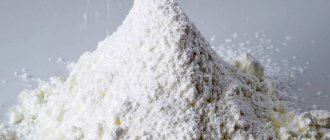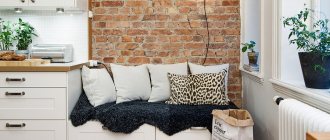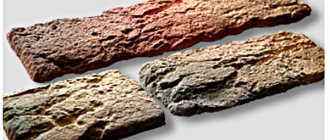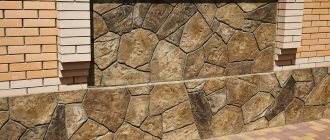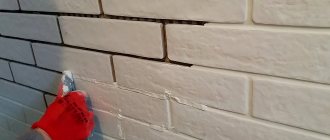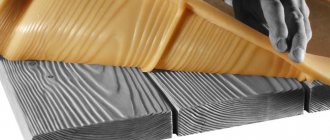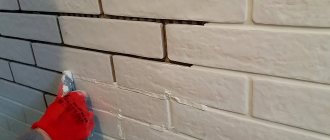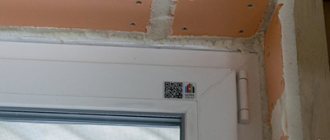Artificial stone is considered a relatively new building material, but it has already become popular throughout the world. Cladding type material helps to quickly decorate the facade of a building or a garden area. The cost of the finished stone is quite high, so some people make it themselves. To do this, you can either purchase a ready-made form that will have the most suitable texture, or make it yourself.
Effective turnkey solution
What is a mold for decorative stone
A mold for home decorative stone is a flat container with a high ductility index. It has a bottom in the form of the relief that is needed for the manufacture of building material. The product is also divided into several different elements, depending on the required design. Forms can be made from different materials and are selected taking into account what kind of raw materials will be used for filling.
Matrix - what is it?
The matrix is the same mold that is used to produce artificial stone at home. Purchased models are expensive, so you can make the matrix yourself.
- Saving money. Finance will be spent exclusively on raw materials, which cost several times less.
- You can come up with your own original design for the product being manufactured.
- The person will gain useful skills. If you learn how to make simple matrices, then over time the knowledge gained can be applied in some other areas.
- Spin off. If the matrix is made correctly, it will last several times longer than purchased products.
What requirements apply to forms?
The quality of artificial stone will largely depend on what kind of material was used to make the molds. Regardless of this, all forms must meet certain requirements.
- Mechanical strength. A high-quality form should stretch easily and be durable. It should not break or tear if significant force is applied. In addition, the form must necessarily restore all its geometric contours.
- Abrasion resistance. Products of this type must convey everything, even the smallest details of the artificial stone relief.
- High chemical resistance. Most solutions used to produce artificial stone may contain some alkaline elements. They can cause destruction of the mold structure.
Advantages and disadvantages
Decorative gypsum bricks have many advantages, which are as follows:
- Creating a good indoor microclimate. Possessing hygroscopicity, the material is able to take away some of the moisture from the air, which it releases when there is a lack of it.
- Fire resistance. Gypsum is not subject to combustion, which means it is not a source of flame propagation.
- Additional thermal and sound protection of the object. The product creates a coating that retains heat inside the room and also prevents the penetration of noise pollution.
- Light weight. The design does not exert significant load on the surface. Therefore, such bricks are excellent for finishing partitions.
- Large selection of colors and relief. This makes it possible to show a full flight of fantasy and design imagination.
- Easy to install. To work you will need a minimum set of tools and skills.
- Possibility of self-production. This significantly reduces the overall costs of finishing activities.
One of the main advantages of gypsum brick is its ease of installation
. Of course, there are some disadvantages. The negative points include low resistance to mechanical damage. That is, it is quite easy to damage the material. But with some skill, it is possible to restore the coating.
What are molds made of?
Today, a variety of materials are used to make molds. Regardless of this, they all have the same principle of “work”. There are such types of forms as:
This will provide some benefits.
- silicone;
- plastic;
- wooden;
- polyurethane.
Modern forms for making decorative stone can be easily made with your own hands at home, regardless of what kind of material will be used.
Made of wood
Wooden
Wooden products are considered far from the most successful option, but they are still worth mentioning. In order to make a matrix from wood, you need to find old boards that have as many defects as possible. These could be knots, bulges, cracks, etc. The “worse” the condition of the board, the more beautiful the structure the decorative stone can achieve.
During the procedure, it is very important that the finished stone not only has a sufficiently embossed surface, but also smooth walls. For the bottom of the wooden matrix you need to use special textured boards, and for the walls - plywood or small slats.
All parts used must be carefully connected to each other and secured well with nails. The joints are sealed so that not even a small gap remains. These forms are inexpensive and easy to use, but the quality of the resulting stone can be very poor.
Silicone
Silicone
Silicone molds are a plastic plane, the bottom of which is given the desired relief. Such products are usually divided into several compartments so that more stones can be obtained at a time.
Silicone molds have a huge number of advantages when compared with other types.
- The product is very durable, soft and at the same time elastic.
- It is done very simply - special components are mixed in a certain proportion.
- By changing the ratio of components, you can change the properties of the finished form.
- To increase the strength of the matrix, it is necessary to remove air bubbles that appear during the production of the product. To do this, you can use a special vacuum machine.
Not all silicone can be used for this type of product. It is worth choosing raw materials with a sufficiently high viscosity index.
Polyurethane molds
Polyurethane
are considered the most convenient and common to use. They are durable, elastic, and allow you to get a high-quality imprint of the texture of artificial stone. Polyurethane matrices have a long service life. Polyurethane molds for the production of decorative stone are much better than silicone ones and do not require the additional use of a vacuum machine.
Using plastic
You cannot make such a form yourself. Plastic matrices are quite rigid and must be used carefully. They have a low price and are often used for the production of paving slabs.
DIY brick.
Naturally, the material for making bricks with your own hands is clay. There are many options for obtaining clay, the main thing is to find it in sufficient quantity. You can try visiting quarries in the area, or it may be right on your property. But, it is worth considering the composition and quality of the clay; not every type and type of clay is suitable - we advise you to check whether it is suitable in quality and what its fat content is.
for determining the fat content of clay ; they can be found below.
Take some clay, about half a liter. Gradually we begin to pour and mix water into the clay. We continue until the clay absorbs water and begins to stick to our hands. Next, you need to give the mass the shape of a ball (3-4 cm in diameter) and a flat cake (about 10 cm in size), and leave to dry for several days.
After two or three days, it is necessary to inspect the figures. The presence of cracks indicates that it is necessary to add sand to the clay, because... she's too fat. If there are no cracks, a strength test must be carried out. To do this, you need to throw the ball from a height of about a meter. If the ball scatters into pieces, then the clay is thin and not suitable for making bricks. Clay with a higher fat content should be added to the existing raw materials. If the Ball remains unharmed, then brick production can begin.
It should be remembered that it is necessary to mix clay or sand in small portions, and control the quality of the raw materials after each batch. This will allow you to find the optimal proportion and avoid mistakes.
How to make a matrix
Making a matrix with your own hands is quite simple. Be sure to follow the step-by-step instructions to ensure a high-quality product.
Selection and preparation of models
The very first stage of production is the preparation of a special master model. The sample must be cleaned of dust, dirt, and dried. Under no circumstances should moisture be present. The inner surface of the box and the model itself are lubricated with release agent. The substance is applied in an even layer, not very thick, so that the texture and texture of the stone being manufactured is not lost. The sample is left to dry for 10-15 minutes.
Model preparation
Next, the model is warmed up using a hair dryer. This procedure is mandatory and is necessary so that the paraffin release agent melts and fills all the micropores present. The excess substance will drain off so that the stone has the most accurate texture possible.
Laying and installation of master models
The model is assembled by screwing the sides and aligning them level. The form must be sealed around the entire perimeter so that the solution does not leak out of it.
Mixing components
All components of the mixture must be weighed and mixed in a bucket using a drill for five minutes. The rotation of the blades must be counterclockwise to avoid the formation of air bubbles.
Important! The components should be at room temperature. During pouring, the room temperature should be within 20-25 degrees, the humidity level should be no more than 50%.
Filling with compound
Once the components are mixed, you have a maximum of 15 minutes to pour the mixture onto the master model. This time will be enough for the compound to transition from a liquid to a gel state.
You need to pour the mixture carefully from one corner. This will allow you to fill out the entire form without any gaps. The formwork with the solution is left until it hardens completely.
Pouring
At the last stage, the formwork is removed and the finished artificial stone is removed. The procedure is performed no earlier than one day after pouring. Then you need to cut off all unnecessary sagging. The matrix can be used only after a few days, when it reaches its maximum strength.
Preparing silicone for pouring
To make silicone, two components are needed: a catalyst and a hardener. It is necessary to read the instructions and carefully follow the proportions. Next, combine the components together and then mix thoroughly using a drill or electric mixer.
When the mixture is thoroughly mixed, you need to leave the silicone to infuse for 20-30 minutes. At this time, you should once again check the previously prepared elements to make sure that everything is done efficiently and reliably. It is recommended to make several holes in the plasticine.
Assessment of the quality of molds for the manufacture of decorative stone
Don’t worry if the mold for making decorative stone at home doesn’t turn out perfect the first time. A couple of trainings and you will be able to make high-quality goods with minimal costs only on raw materials.
Quality control
Purchased products from reputable manufacturers may be of higher quality than homemade ones. Nowadays there are many fakes on the construction market and no one guarantees that you will be able to purchase a truly worthwhile product the first time.
Where can the material be used?
Currently, there are various types of products on the market. They differ in their external properties. There are the following types of decorative tiles:
- Glossy. It is obtained by applying a layer of varnish.
- Matte. The treatment is carried out with special impregnations that increase the protective properties of the material.
- Embossed. The drawing is completely individual.
- Convex and concave.
Gypsum brick can vary in color, relief, texture and shape
The number of existing shades is very large. If necessary, additional painting of the product can be carried out.
The material is suitable for use in various rooms, but exclusively inside a house or apartment. It is also necessary to take into account that its use is unacceptable in the following places:
- in the bathroom or shower;
- next to the kitchen sink and gas stove;
- for facing fireplaces.
The coating looks quite impressive when combined with other types of finishing products.
Gypsum brick can only be used for finishing dry rooms
Advice from experts
- All stages of production must be carried out very carefully.
- It is important to carefully monitor the proportions of the components used.
- There is no need to rush to remove the finished stone from the molds. It is better to let it sit for a few extra hours so that it hardens well.
- You need to use only high-quality raw materials to ensure that the products are strong and durable.
Making molds for artificial stone yourself will save a decent amount of money. The process is quite simple and anyone can easily handle it.
Advantages and disadvantages
Decorative gypsum bricks have many advantages, which are as follows:
- Creating a good indoor microclimate. Possessing hygroscopicity, the material is able to take away some of the moisture from the air, which it releases when there is a lack of it.
- Fire resistance. Gypsum is not subject to combustion, which means it is not a source of flame propagation.
- Additional thermal and sound protection of the object. The product creates a coating that retains heat inside the room and also prevents the penetration of noise pollution.
- Light weight. The design does not exert significant load on the surface. Therefore, such bricks are excellent for finishing partitions.
- Large selection of colors and relief. This makes it possible to show a full flight of fantasy and design imagination.
- Easy to install. To work you will need a minimum set of tools and skills.
- Possibility of self-production. This significantly reduces the overall costs of finishing activities.
One of the main advantages of gypsum brick is ease of installation
Of course, there are some disadvantages. The negative points include low resistance to mechanical damage. That is, it is quite easy to damage the material. But with some skill, it is possible to restore the coating.
Briefly about the main thing
Artificial stone is a material made from cement and sand. Gypsum is also used. The composition also includes water, dyes, and plasticizers. Ceramic, polyester, acrylic, reinforced and liquid stone on gelcoat are also produced. They are used to create shelves, sinks, furniture items, and boulders.
The material is lightweight, fireproof and affordable. It is made in different colors, shapes and textures. Its durability is less than that of natural stone.
During production, molds are used in which the mixture hardens. Coloring is done during the mixing process or after the tiles have dried. There is a manufacturing option using a lined stencil and without a mold.
Ratings 0
Where can the material be used?
Currently, there are various types of products on the market. They differ in their external properties. There are the following types of decorative tiles:
- Glossy. It is obtained by applying a layer of varnish.
- Matte. The treatment is carried out with special impregnations that increase the protective properties of the material.
- Embossed. The drawing is completely individual.
- Convex and concave.
Gypsum brick can vary in color, relief, texture and shape
The number of existing shades is very large. If necessary, additional painting of the product can be carried out.
The material is suitable for use in various rooms, but exclusively inside a house or apartment. It is also necessary to take into account that its use is unacceptable in the following places:
- in the bathroom or shower;
- next to the kitchen sink and gas stove;
- for facing fireplaces.
The coating looks quite impressive when combined with other types of finishing products.
Gypsum brick can only be used for finishing dry rooms
Description
In appearance, this material is very similar to natural rocks . The tiles obtained from a hardened special mortar have proven their practicality and durability.
Natural minerals, when external conditions, temperature, humidity change, change their properties and characteristics, which is reflected in their appearance. The weight of natural stones increases the load on the foundation or walls.
Artificial stones are free from all these disadvantages. In addition, the significantly lower price, compared to natural wood, has finally won over buyers.
An increasing number of people want to surround themselves with natural materials, but at the same time take advantage of modern technologies: reliability, durability, and a constantly well-groomed appearance.
The next stage is creating a gypsum mixture for the bed
To do this, mix PVA glue with water, which is then added to the plaster. A little cement is added there to give additional strength. As for the glue, it plays the role of a plasticizer.
We pour the resulting gypsum mixture into our formwork onto the product.
During this process, you should also coat all pores with a brush. When pouring the gypsum mixture into the formwork, the resulting layers should be leveled with a spatula.

